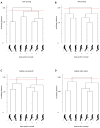The mental representation of the human gait in young and older adults
- PMID: 26236249
- PMCID: PMC4500916
- DOI: 10.3389/fpsyg.2015.00943
The mental representation of the human gait in young and older adults
Abstract
The link between mental representation (MREP) structures and motor performance has been evidenced for a great variety of movement skills, but not for the human gait. Therefore the present study sought to investigate the cognitive memory structures underlying the human gait in young and older adults. In a first experiment, gait parameters at comfortable gait speed (OptoGait) were compared with gait-specific MREPs (structural dimensional analysis of MREP; SDA-M) in 36 young adults. Participants were divided into a slow- and fast-walking group. The proven relationship between gait speed and executive functions such as working memory led to the hypothesis that gait pattern and MREP differ between slow- and fast-walking adults. In a second experiment, gait performance and MREPs were compared between 24 young (27.9 years) and 24 elderly (60.1 years) participants. As age-related declines in gait performance occur from the seventh decade of life onward, we hypothesized that gait parameters would not be affected until the age of 60 years accompanied by unchanged MREP. Data of experiment one revealed that gait parameters and MREPs differed significantly between slow and fast walkers. Notably, eleven previously incurred musculoskeletal injuries were documented for the slow walkers but only two injuries and one disorder for fast walkers. Experiment two revealed no age-related differences in gait parameters or MREPs between healthy young and older adults. In conclusion, the differences in gait parameters associated with lower comfortable gait speeds are reflected by differences in MREPs, whereby SDA-M data indicate that the single limb support phase may serve as a critical functional period. These differences probably resulted from previously incurred musculoskeletal injuries. Our data further indicate that the human gait and its MREP are stable until the age of 60. SDA-M may be considered as a valuable clinical tool for diagnosis of gait abnormalities and monitoring of therapeutic effectiveness.
Keywords: aging; long-term memory; normal and pathological gait; structural dimensional analysis of mental representation (SDA-M).
Figures



Similar articles
-
The mental representation of the human gait in patients with severe knee osteoarthrosis: a clinical study to aid understanding of impairment and disability.Clin Rehabil. 2018 Jan;32(1):103-115. doi: 10.1177/0269215517719312. Epub 2017 Jul 19. Clin Rehabil. 2018. PMID: 28719981
-
The mental representation of the human gait in hip osteoarthrosis and total hip arthroplasty patients: A clinical cross-sectional study.Clin Rehabil. 2019 Feb;33(2):335-344. doi: 10.1177/0269215518804294. Epub 2018 Oct 16. Clin Rehabil. 2019. PMID: 30322264
-
An Investigation of the Predictors of Comfortable and Fast Gait Speed in Community-Dwelling Older Adults.J Geriatr Phys Ther. 2019 Oct/Dec;42(4):E62-E68. doi: 10.1519/JPT.0000000000000216. J Geriatr Phys Ther. 2019. PMID: 30418341
-
Dual-task effects of spontaneous speech and executive function on gait in aging: exaggerated effects in slow walkers.Gait Posture. 2011 Feb;33(2):233-7. doi: 10.1016/j.gaitpost.2010.11.011. Epub 2010 Dec 28. Gait Posture. 2011. PMID: 21193313
-
Contributions to the understanding of gait control.Dan Med J. 2014 Apr;61(4):B4823. Dan Med J. 2014. PMID: 24814597 Review.
Cited by
-
Comparison of a Wearable Accelerometer/Gyroscopic, Portable Gait Analysis System (LEGSYS+TM) to the Laboratory Standard of Static Motion Capture Camera Analysis.Sensors (Basel). 2023 Jan 3;23(1):537. doi: 10.3390/s23010537. Sensors (Basel). 2023. PMID: 36617135 Free PMC article.
-
A low-cost vision system based on the analysis of motor features for recognition and severity rating of Parkinson's Disease.BMC Med Inform Decis Mak. 2019 Dec 12;19(Suppl 9):243. doi: 10.1186/s12911-019-0987-5. BMC Med Inform Decis Mak. 2019. PMID: 31830986 Free PMC article.
-
Comparison of Treadmill Gait Between a Pediatric-Aged Individual With SYNGAP1-Related Intellectual Disability and a Fraternal Twin.Front Hum Neurosci. 2022 Jun 22;16:918918. doi: 10.3389/fnhum.2022.918918. eCollection 2022. Front Hum Neurosci. 2022. PMID: 35814954 Free PMC article.
-
An Adaptable Human-Like Gait Pattern Generator Derived From a Lower Limb Exoskeleton.Front Robot AI. 2019 May 14;6:36. doi: 10.3389/frobt.2019.00036. eCollection 2019. Front Robot AI. 2019. PMID: 33501052 Free PMC article.
-
Perceptual-Cognitive Changes During Motor Learning: The Influence of Mental and Physical Practice on Mental Representation, Gaze Behavior, and Performance of a Complex Action.Front Psychol. 2016 Jan 8;6:1981. doi: 10.3389/fpsyg.2015.01981. eCollection 2015. Front Psychol. 2016. PMID: 26779089 Free PMC article.
References
-
- Abellan van Kan G., Rolland Y., Andrieu S., Bauer J., Beauchet O., Bonnefoy M., et al. (2009). Gait speed at usual pace as a predictor of adverse outcomes in community-dwelling older people an International Academy on Nutrition and Aging (IANA) Task Force. J. Nutr. Health Aging 13 881–889. 10.1007/s12603-009-0246-z - DOI - PubMed
-
- Bernstein N. A. (1967). The Coordination and Regulation of Movement. London: Pergamon Press.
-
- Bläsing B., Tenebaum G., Schack T. (2009). The cognitive structure of movements in classical dance. Psychol. Sport Exerc. 10 350–360. 10.1016/j.psychsport.2008.10.001 - DOI
LinkOut - more resources
Full Text Sources
Other Literature Sources
Research Materials

